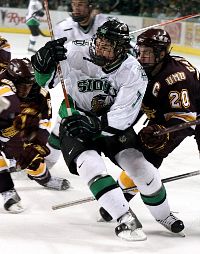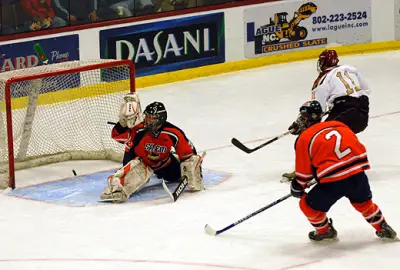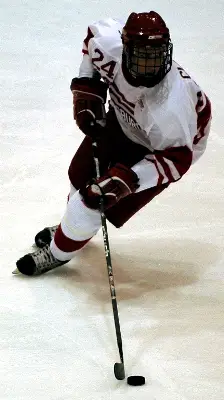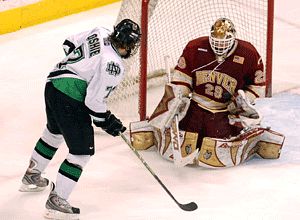Kevin Porter was named player of the year in the CCHA Thursday night, which should come as no surprise.
Here is the surprise. The Hobey Baker top 10 finalists were also released, and where were Ryan Cruthers and Chad Kolarik? As a voting member of the committee, I was stunned that neither of these two players were among the elite group names in the top 10. I could make a great case for both to be there, and as a matter of fact I will.
I don’t mean to get off on a rant here, but hey, NCAA coaches, c’mon! Kolarik on any other team could be as dominant as Porter. Now maybe a case can be made that Porter’s steadying influence on the fun-loving Kolarik has made Chad a better player and a better teammate. I’ll buy that.
This kid has been great all season and despite the perception from outsiders that he is riding in the shadow of Porter, nothing could be further from the truth. Kolarik was inconsistent as an overall player in his first three years, but sometime in his sophomore season, head coach Red Berenson got into his head about consistency and being a better two-way player. Thus, the one-dimensional player became a superstar. The kid has a pair of four-goal games and I don’t care if you’re playing Lake Superior State or Plattsburgh State, four goals in a game is four goals.
Now, here are some of his numbers under closer evaluation. He has points in 23 of 34 games this season and went 9-12–21 on the road, though four road goals were at Western Michigan in one game (as a side note, both of his four-goal games were on CSTV). However, here’s where his efforts get weighted. Michigan goes on the road and gets everyone’s A game so his road points get a little more consideration.
He had point streaks of seven and six games during the season and a hat trick in game 1 of their series against UNO, returning from a badly pulled hamstring. In what we call “big games” (games against rivals, games in tough arenas) he had 6-8–14 in seven games, which is pretty darn good. He had six points in the College Hockey Showcase during which Michigan went 2-0. He has a goal and three assists at Miami in a late-season matchup of the No. 1 and No. 2 teams in the country; Miami was the top-ranked defensive team in the nation at the time. However, in four games against Michigan State and Notre Dame, he has a goal and an assist.
Now, look at this the other way. Those two teams have enough depth to shut down his line without a consistent matchup of defensemen. That means teams can gun for him, Porter and Pacioretty and still have enough to win games and that is what happened. Notre Dame blanked his line at Yost with Teddy Ruth and Brock Sheehan putting on a clinic in terms of how to be a shutdown defensive pair.
He blocks shots, takes the body, competes, and while he may be a little chirpy like T.J. Hensick was, players I have talked to league-wide compliment him on his combativeness but feel he just talks too much on the ice. I’ve evaluated players for close to 20 years and Kolarik measures up in every category with anyone in the top ten. A case can be made that some coaches missed the boat on Kolarik.
Now for Cruthers. Let’s take his being an Apple Core alumnus out of this for a minute and get rid of that notion that he has all those points because he plays in a “mid-major,” College Hockey America. Cruthers was dominant this season and he plays on a team that has less depth than some of the players on teams in the “Big Four” conferences. Also, the majority of his games in conference were against Bemidji State and Niagara, and those teams are among the best defensively in the nation. Look at their goals against out-of-conference opponents and you can see Cruthers had no easy time getting his points.
He had 7-9–16 in 15 games that I’d classify as “big” games. That includes points against Ohio State, BU, Princeton, Colgate, and CHA rivals Bemidji State and Niagara. In 18 games away from home he put up 26 points and that’s impressive. Of those teams, Niagara is a conference champ and everyone except Bemidji is still playing in their conference tourney’s final four.
He had 17 multipoint games and point streaks of seven and eight games, when he scored 15 and 14 points, respectively. His 1.44 points per game was among the best in the country.
I won’t disrespect the student-athletes in the top 10 by saying these two should bump two out; that isn’t fair. But I will say that these two deserved a place in that top 10 and because they are not, they should be recognized for the elite players that they are.
Spend ten minutes on the CCHA website and you’ll see why the conference has moved ahead of the other five in terms of the way it presents themselves. Like Hockey East, the CCHA is very media-friendly. They get it, and Thursday night at the Fox Theatre in Detroit they held the CCHA awards banquet and pulled off an event that should be a staple of the Big Four conferences in terms of showing the sports world what first-class is about.
Led by commissioner Tom Anastos and his never-go-to-sleep staff at the CCHA office, the banquet was impressive. Hosted by (CCHA Communications Director and FSN Detroit analyst) Fred Pletsch and (the lovely and talented) Shireen Saski of FSN Detroit, the pace, presentations, accompanying video and overall production was in the category of any televised awards show and had an Academy Awards-like feel to it.
Honored by the league for his decades of service, founding father Ron Mason was touched by the accolades and video tribute as he retired as the Director of Athletics at Michigan State. Mason mentioned in his remarks that this banquet was a cut above even the Big Ten football event.
College hockey will always be fighting for a place on the sports scene, but more than ever college hockey has a presence on TV. There are no fewer than 10 networks that I could name off the top of my head that televise college hockey games, including CSTV (now the CBS College Sports Network), FSN Detroit, FSN Rocky Mountain, NESN, ESPNU, Leafs TV, CN8, Nebraska Public TV, New Hampshire Public TV, Comcast, FSN North and many other local packages nationwide. Add the B2 networks who stream games and there is no shortage of college hockey via traditional and new media.
Because of events like the CCHA awards banquet and the production and preparation that goes into it, our sport has the ability to impress, polarize, and cultivate fans in major markets like Boston, Detroit, and Minneapolis. This sport needs to continue to push the envelope in terms of marketing, grass roots involvement, and growth. Events like this go long way and the CCHA should be congratulated not only for this but for their efforts on every public front like their media day, Hockey Day in Michigan, and the Have Fun Play Hockey Clinics run by Courtney Welch in the CCHA office.
On a personal note, CSTV and the CCHA have enjoyed a great relationship in the past five years. We were two companies who thought that by thinking big picture we could accomplish many things, and from the TV side of it, I’d like to think we have helped each other grow to new heights. No other TV outlet has put the CCHA on a national broadcast as much as CSTV.
Now the league takes the ice at the Joe Louis Arena, Hockeytown, for its championship tourney. Through its’ partnership with the RBC Financial group, the Illitch family, and the Olympia Entertainment group, the CCHA title tourney has been a huge success and should continue to evolve on a yearly basis. This year they are having a huge fan fest throughout the tourney at the Winter Gardens at the Detroit Renaissance Center.
I’ve always considered Boston the Hub of Hockey in the United States. The Bruins, the quantity of great Division I and Division III hockey within close proximity. The Beanpot, which is the best tourney of the season, and the quality of prep and junior A hockey in the region make it a mecca for all things pucks. Hockey East dominates discussions at rinks across New England as much as the Bruins do, and when you have three coaching legends in Jerry York, Jack Parker and Dick Umile, you’ve got clout nationally.
However, Detroit and the markets of the CCHA have shown great passion for their teams and this league will continue to grow. When you have Michigan, Notre Dame, Ohio State and Michigan State in your conference, marketing possibilities are endless rivalries abound. The CCHA has been able to manipulate that and should continue to do so as the caliber of play continues to match and at times surpass that of any conference in the country



